Spike Island: How The Stone Roses inspired Pulp
 Getty Images
Getty ImagesMusic fans wondering what Pulp would do for an encore have finally got their answer as the Britpop legends announced they would be releasing their first new album for almost a quarter of century in June.
The first single from the upcoming More takes a familiar path to their much-loved previous songs, with singer Jarvis Cocker drawing on his own experiences and interactions for its lyrics.
Its main inspiration though is not the band's native Sheffield or Cocker's meandering life through London, Paris or the Peak District, but a gig that has a special place in music history - The Stone Roses' almost legendary show at Spike Island.
Held on the banks of the Mersey in Widnes, Cheshire, at the height of the Madchester pioneers' fame in 1990, it has become one of rock music's most mythologised gigs.
Who were The Stone Roses?
Formed in Manchester in 1985, The Stone Roses originally featured singer Ian Brown, guitarist John Squire, bass player Gary 'Mani' Mounfield and drummer Alan 'Reni' Wren.
With singles such as This Is the One, I Am the Resurrection and Fools Gold, they provided some of the biggest soundtracks of the Madchester music scene in the late 1980s and early 1990s.
The movement saw an explosion of a musical and cultural scene in their home city, where a blend of indie rock, acid house, psychedelia and 1960s pop rose in popularity.
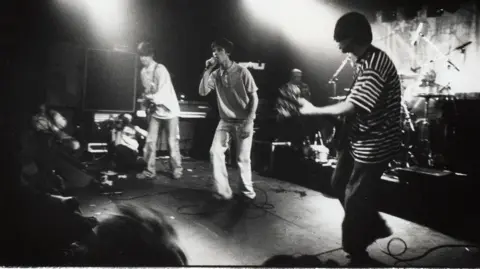 Getty Images
Getty ImagesMatt Mead, who has published a book about the band, said they were "the biggest band at that time".
"They were as big, if not bigger, than U2, who were massive," he said.
"Their musicianship was second to none.
"You just had four members, but there was some sort of magic that happened when they were on stage."
Along with the music, the band also had a distinctive style, leading fans to adopt baggy clothing, mop haircuts and bucket hats.
Their beloved Manchester United even launched a kit collection in 2024 inspired by the band.
Why did they play Spike Island?
As part of their series of gigs, The Stone Roses held a concert at Spike Island on a sunny day on 27 May 1990.
It seemed like the ideal spot, almost equidistant from the huge musical hubs of Manchester and Liverpool and the band's legions of North-West fans.
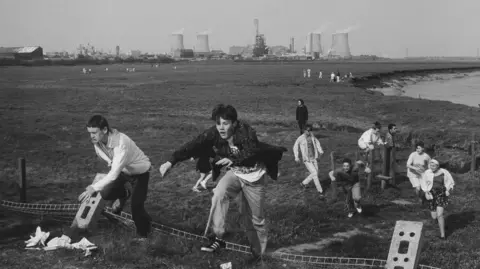 Getty Images
Getty ImagesCreated after the 1833 extension of the Sankey Canal in Widnes, Cheshire, the island was the centre of Britain's chemical industry during the Industrial Revolution.
Factories and railways dominated the area until the industry went into decline in the 20th Century.
The area has now become a haven for wildlife with paths for walkers and cyclists.
What happened at the concert?
Official figures suggest about 28,000 people attended the concert on 27 May 1990 but Mead reckons that goes up to about 30,000 if gatecrashers were included.
Dave Haslam performed a DJ set before The Stone Roses' performance.
He said there was an element of chaos from the start as the band's management booked the wrong DJ acts, getting rave favourite Frankie Bones instead of house legend Frankie Knuckles.
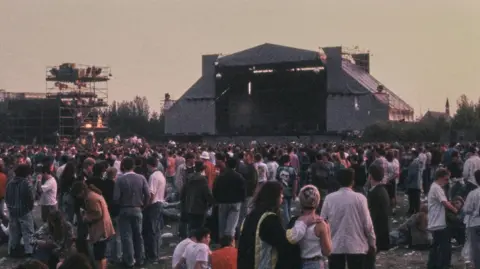 Getty Images
Getty ImagesHe said that sort of misstep was "evidence of the endearing amateurism around the gig".
"My generation were not really into open air festivals," he said.
"Glastonbury wasn't anywhere like it is as big now.
"We liked rave venues or basement live music.
"We liked sweaty little venues clubs in the middle of town."
There have been mixed reviews of the concert with Pulp guitarist Mark Webber telling BBC 6 Music describing the show as "a slight anticlimax".
"There was a lot of anticipation but it didn't sound very good," he said.
"It was very windy and the vibe wasn't there."
Haslam said that was another example of the lack of experience of putting on such big shows.
"I don't think anyone appreciated that you need to a lot of amplification to reach the back of the crowd, because all the sound just gets lost in the atmosphere," he said.
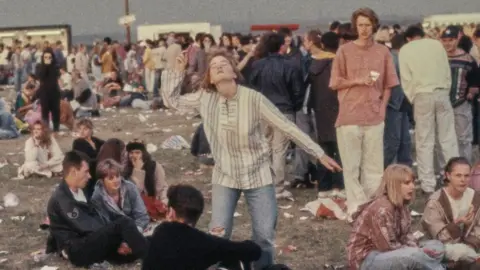 Getty Images
Getty ImagesMead, who is helping on a documentary project about the concert, said recently-found footage revealed "key moments".
"When the band play I Wanna Be Adored and you see the crowd, it's electric," he said.
"It's like nothing else – wall-to-wall bouncing from the front to the back."
He said there was also "blissed-out dancing" during Fools Gold and "everyone's arms in the air" for I Am the Resurrection.
Haslam also remembers fans filing out of the gig in "very, very high spirits".
"Whatever the problems with the sound and waiting around and all of that, I think for those young people, they knew they'd had a day out to remember," he added.
Why has it become the stuff of legend?
Until a full recording came to light in 2024, it was thought the concert had not been captured on film, making it the subject of much mystique for those who weren't there.
But even with the new find, Haslam believes the gig was significant because The Stone Roses "didn't play that often" and it felt like "a life-changing moment".
"It was an opportunity to see this band that had somehow seemed to be the most significant band of the era.
"It was the culmination of two or three years when a certain look and a sound that was a kind of cross between funky indie and rave really animated a new generation."
He said the Spike Island show was part of a series of gigs that "took The Stone Roses from being a big local band and a kind of Manchester secret to being internationally renowned".
Crews travelled from France and Germany for the event while fans came from across the country.
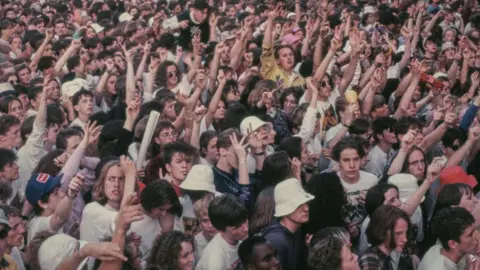 Getty Images
Getty ImagesHaslam said there "wasn't really anything similar afterwards" for the band due to the time it took the band to release a second album.
"That took far too long - four or five years - so a lot of the momentum went out of the Roses at that point and by the time they came back, that part of the world had all moved on to Oasis".
He said Spike Island "was the only moment where you had The Stone Roses absolutely at their peak, playing music that had been quite underground but had been becoming accepted by the mainstream - that mix of euphoric rave vibe with rock music".
What happened to The Stone Roses?
After the Spike Island show, The Stone Roses became embroiled in a long legal battle with their record label and did not release a follow-up album, The Second Coming, until 1994.
Three months after its release, Reni left the band and was followed a year later by Squire.
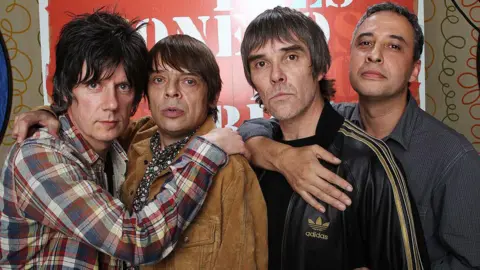 Getty Images
Getty ImagesBrown and Mani tried to carry on with guitarist Aziz Ibrahim and drummer Robbie Maddix joining the band, but within a few months, they dissolved the band.
Squire, Brown and Mani went on to have post-Roses success, while Reni left music altogether.
After years of rumours, the original line-up finally reformed in 2011, going on to play huge gigs across the globe before Squire confirmed in 2019 that they had split once more.
How did the gig come to inspire Pulp?
Though Pulp had been a working band for over a decade when Spike Island happened, they did not break into the mainstream until the release of their His 'n' Hers album in 1994, before becoming huge stars with the release of their landmark single Common People a year later.
That song was taken from their most successful album, Different Class, which also spawned the hit, Sorted for E's and Wizz, which Cocker has now revealed was a sister song to the new single and was also based on a fan's experience of the Stone Roses' gig.
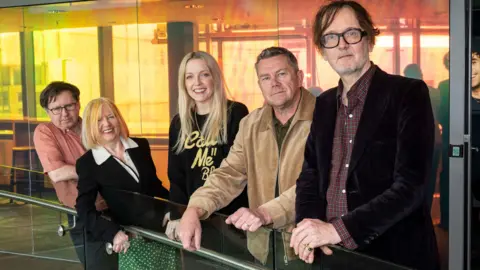 PA Media
PA MediaThe inspiration for that track was "a girl that I was speaking to at The Leadmill (nightclub) in Sheffield one night," he said.
"She said all that she could remember were people going round saying, 'Is everyone sorted for E's and wizz?'.
"So that phrase stuck in my mind."
He said he did not go to Spike Island, but had written the new song's lyrics after speaking to various attendees, including musician Jason Buckle, from the band All Seeing I, who co-wrote the single.
"All he could remember was a DJ who between every song said, 'Spike Island come alive, Spike Island come alive'," he said.
"That phrase stuck with me.
"I've got a very short attention span I think."
Read more stories from Cheshire on the BBC, watch BBC North West Tonight on BBC iPlayer and follow BBC North West on X. You can also send story ideas via Whatsapp to 0808 100 2230.
